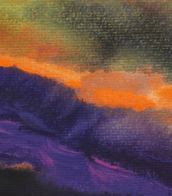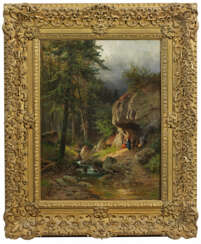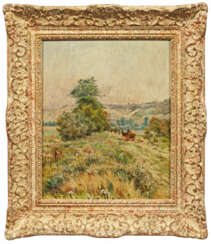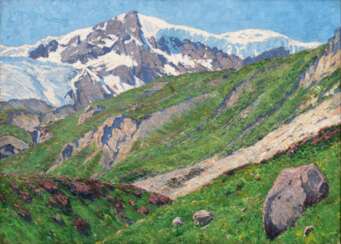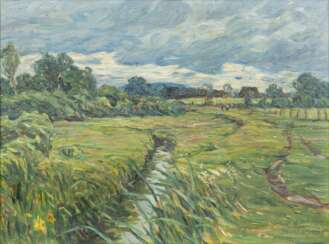carl reiser

Carl Reiser was a German painter, professor at the Academy of Fine Arts in Munich. In addition to portraits Reiser was famous for his winter city and mountain landscapes, still lifes. He used all known techniques: watercolor, gouache, tempera and oil.


Carl Spitzweg was a German romanticist painter, especially of genre subjects. He is considered to be one of the most important artists of the Biedermeier era.


Carl Spitzweg was a German romanticist painter, especially of genre subjects. He is considered to be one of the most important artists of the Biedermeier era.


Carl Wuttke was a German painter of the last quarter of the nineteenth and first quarter of the twentieth centuries. He is known as a landscape and architectural painter.
Carl Wuttke traveled extensively, visiting Italy, Spain, Norway, Africa, the United States, China and Japan. He created many paintings, including paintings for German Emperor Wilhelm II. Wuttke, although he specialized in landscape, also painted genre scenes. His vivid colors and style make him one of the forerunners of Impressionism


Carl Eduard Ferdinand Blechen was a German landscape painter, recognized for his pivotal role in the Romantic movement. Blechen transitioned from a banking job to pursue art, studying at the Berlin Academy and embarking on inspirational journeys to Italy and Dresden. His work, characterized by its vivid landscapes and emotional depth, reflected a new direction in painting, deeply influenced by his travels.
Notably, Carl Blechen's contributions to art were not limited to his creations; he was a respected educator, shaping the next generation of artists as a Professor of Landscape Painting at the Berlin Academy. Despite his professional success, Blechen battled with mental illness, which ultimately affected his career and led to his early death in 1840.
Carl Blechen's artworks, including "The Interior of the Palm House on the Pfaueninsel Near Potsdam," resonate with the Romantic ideals of natural beauty and emotional expression. While many of his pieces are in private collections, his legacy endures, influencing not only landscape painting but also the broader art historical narrative.
For art collectors and enthusiasts, Carl Blechen's work offers a window into the Romantic era's soul, capturing the transient beauty of nature and the human experience. His life story, marked by both brilliance and struggle, adds a poignant layer to his artistic achievements.
For those interested in the intersection of art, culture, and history, particularly in the Romantic period, staying informed about Carl Blechen's contributions and related art events can be enriching. Signing up for updates on new product sales and auction events related to Blechen's work is an excellent way to stay connected with this influential artist's enduring legacy.


Carl Spitzweg was a German romanticist painter, especially of genre subjects. He is considered to be one of the most important artists of the Biedermeier era.


Carl Maria Nicolaus Hummel was a distinguished German landscape painter and etcher, renowned for his delicate representations of the natural world. Born in Weimar in 1821, Hummel embarked on his artistic journey under the guidance of Friedrich Preller at the Fürstliche freie Zeichenschule Weimar starting in 1841. His rich legacy is shaped by extensive travels across Europe, capturing the essence of each locale with a keen eye for detail and mood.
Hummel's artistry is marked by his adept use of light and texture, which brings scenes to life with a vibrancy that transcends time. His works, such as the serene "Valley of the Mills, near Amalfi" and the contemplative "Sky Study (Sunset)", showcase his skill in marrying color and form to reflect both the tranquility and the dramatic interplay of natural landscapes.
For art collectors and connoisseurs, Hummel's paintings are a testament to the romantic spirit of 19th-century art. His paintings are prominently featured in prestigious institutions across Northern Europe, including the Musée de la Vie Romantique in Paris. Each piece serves as a window into the historical and cultural narratives of the time, making them invaluable additions to any collection.
Renowned for his meticulous approach and the emotional depth of his work, Hummel's contributions to the world of art continue to inspire and captivate audiences. His ability to capture the sublime beauty of nature makes his work an enduring treasure in the landscape genre of the 19th century.
Stay informed about the latest exhibitions and auction events featuring Carl Maria Nicolaus Hummel's work. Sign up now for exclusive updates tailored for collectors and art history enthusiasts. Your subscription ensures you never miss an opportunity to add a piece of history to your collection.


Carl Spitzweg was a German romanticist painter, especially of genre subjects. He is considered to be one of the most important artists of the Biedermeier era.


Carl Spitzweg was a German romanticist painter, especially of genre subjects. He is considered to be one of the most important artists of the Biedermeier era.


Carl Spitzweg was a German romanticist painter, especially of genre subjects. He is considered to be one of the most important artists of the Biedermeier era.


Carl Spitzweg was a German romanticist painter, especially of genre subjects. He is considered to be one of the most important artists of the Biedermeier era.


Carl Wuttke was a German painter of the last quarter of the nineteenth and first quarter of the twentieth centuries. He is known as a landscape and architectural painter.
Carl Wuttke traveled extensively, visiting Italy, Spain, Norway, Africa, the United States, China and Japan. He created many paintings, including paintings for German Emperor Wilhelm II. Wuttke, although he specialized in landscape, also painted genre scenes. His vivid colors and style make him one of the forerunners of Impressionism


















Carl Emil Uphoff (German: Carl Emil Uphoff) was a German painter and writer who worked in the artists' colony of Worpswede. He first studied at the Folkwang-Kreis under Christian Rolfs and then on study trips to Belgium, Holland and France. In Paris he was promoted by Henri Matisse.
Karl Emil Uphoff was a member of the NSDAP and the Nazi community Kraft durch Freude.















